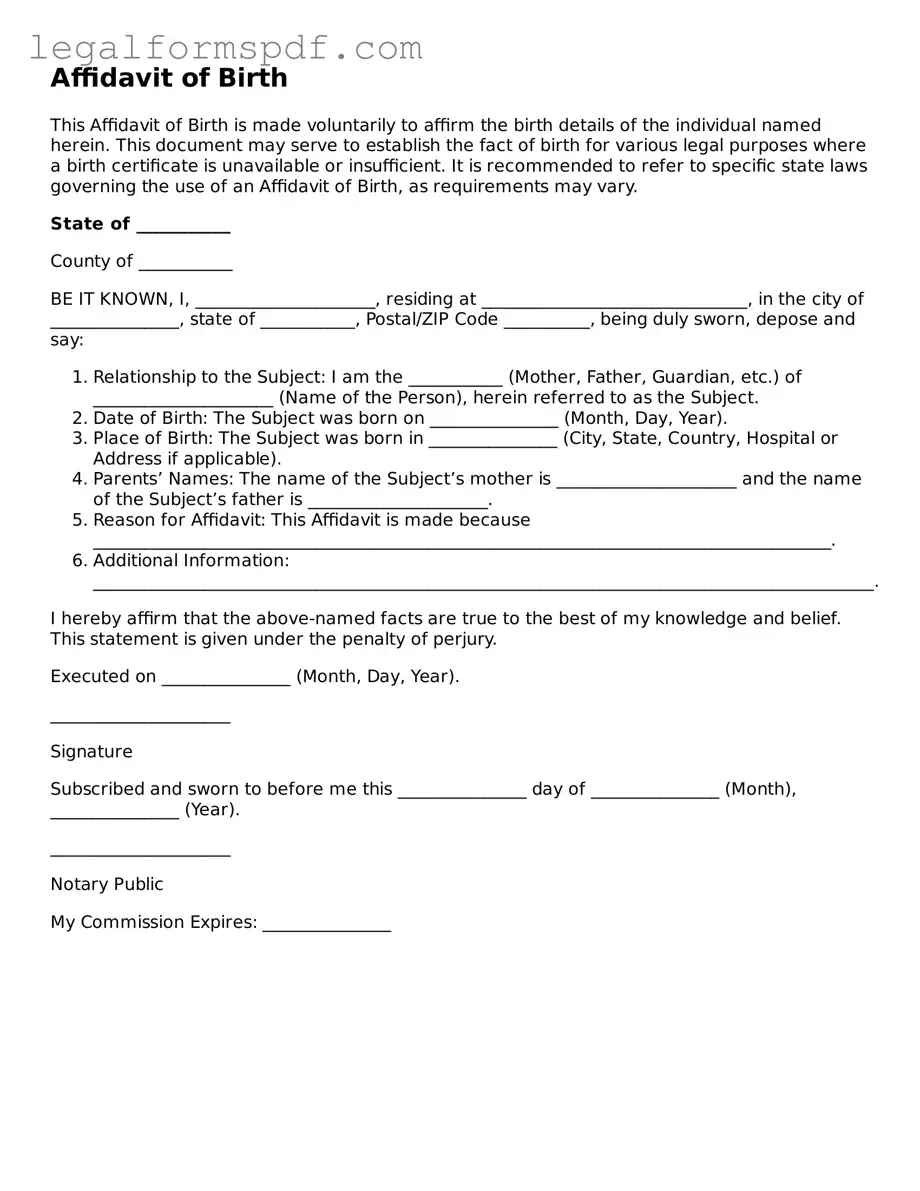An Affidavit of Birth is a document used to legally declare the facts surrounding an individual's birth, especially in situations where the birth certificate is unavailable or needs verification. This document shares similarities with the Affidavit of Death, which serves as a testimony to the facts surrounding an individual's death. Both are sworn statements, used to serve as legal proof for the vital events of birth and death, respectively. They are crucial for various legal purposes, including but not limited to, inheritance claims, social security benefits, and property transfers.
Similar to the Affidavit of Birth, a Marriage Affidavit is a sworn statement that confirms the legality and existence of a marriage between two individuals. This affidavit may be called upon in situations where a marriage certificate is lost or requires additional verification. Just as the birth affidavit proves the circumstances of someone's birth, the marriage affidavit provides legal proof of a marital union, which is essential for matters related to spousal benefits, immigration, and name changes.
The Affidavit of Name Change is another document that aligns closely with the Affidavit of Birth. It's used to formally declare one's change of name and, like the birth affidavit, it is a sworn statement that requires notarization to be considered valid. Both documents are vital for establishing and verifying identity, though for different aspects and purposes. While the birth affidavit confirms the facts of one's birth, the name change affidavit legalizes the transition to a new identity.
An Affidavit of Residency is akin to the Affidavit of Birth as both establish crucial pieces of personal information through sworn testimony. The residency affidavit is often required by educational institutions or government agencies to confirm a person's current place of living. Similar to how a birth affidavit might be used to prove age or citizenship, a residency affidavit validates the place of residence, which can impact school enrollment, voting rights, and tax obligations.
Comparable to an Affidavit of Birth, an Affidavit of Support is a legal document wherein the affiant declares their financial support for another individual, often in immigration cases. This affidavit proves the sponsor's financial ability to support the immigrant, analogous to how a birth affidavit verifies the facts of a person’s birth. Both serve as powerful testimonials within their contexts, carrying substantial legal weight in proving something critical—whether it's the occurrence of birth or the guarantee of financial support.
The Affidavit of Heirship bears resemblance to the Affidavit of Birth in that it establishes a person's claim to a deceased individual's estate based on their relationship. This legal document, like the birth affidavit, is used to confirm personal details crucial for legal processes—in this instance, the succession of inheritance. While the Affidavit of Birth authenticates the event of someone's birth, the Affidavit of Heirship certifies the inheritor's rightful claim to estates or assets.
Similarly, a Court Petition for the Amendment of a Birth Certificate can be likened to an Affidavit of Birth, as both are legal instruments related to the details on a birth certificate. However, the petition goes a step further—requesting the formal amendment of the birth record, which may be required after adoption, gender reassignment, or correcting a mistake on the original document. Both play vital roles in ensuring the accuracy and legality of birth records, ultimately affecting one’s identity and rights.
An Affidavit of Paternity is closely related to the Affidavit of Birth in its purpose to legally recognize and establish paternity. This document is often used to add a father's name to a birth certificate, reinforcing the role of affidavits in certifying personal and familial relations. The verification of paternity can have significant implications for child support, custody, and inheritance, paralleling the birth affidavit's role in confirming the details of someone's entry into the world.
The Power of Attorney (POA) document, while generally broader in application, shares an underlying connection with the Affidavit of Birth through its basis in granting legal authority. In the case of a POA, one grants another individual the right to make decisions on their behalf, whereas, with a birth affidavit, an individual or a guardian affirms personal facts under oath. Both documents necessitate a high degree of trust and legal formalization to validate the authority or information being confirmed.
Lastly, the Declaration of Guardianship is somewhat akin to the Affidavit of Birth through its role in legally establishing relationships and responsibilities for care. This document allows parents or guardians to appoint someone as the guardian of their child, effectively ensuring the child's wellbeing in the event of the parents' inability to do so themselves. Like a birth affidavit, which lays the groundwork for a child's legal identity, a guardianship declaration secures a child's future in terms of care and safeguarding their best interests.
